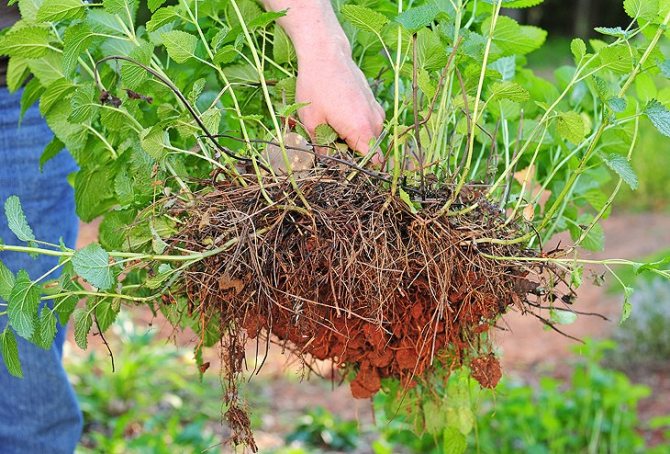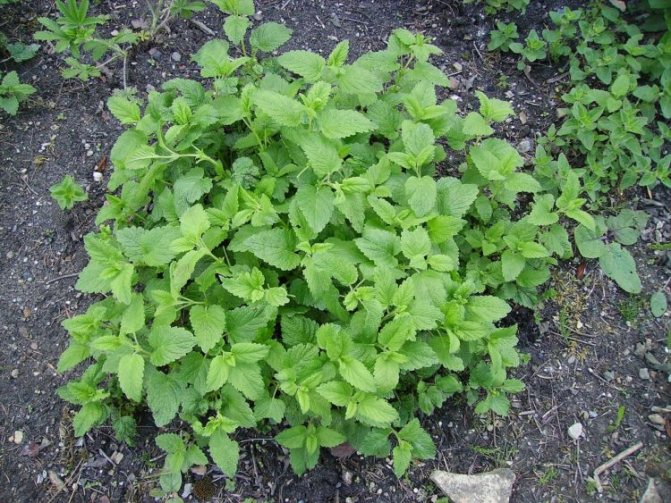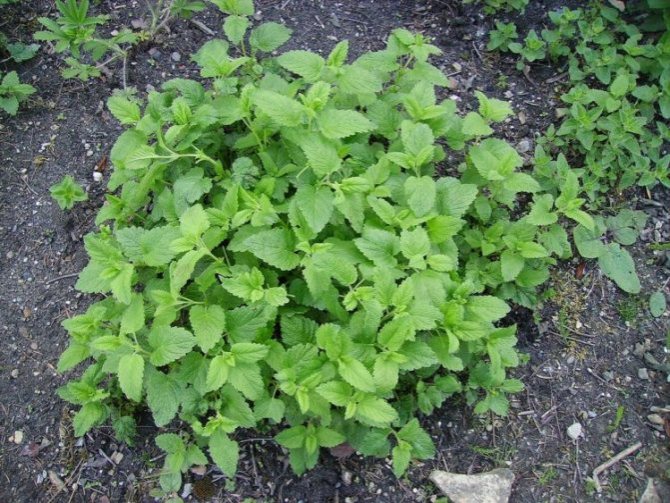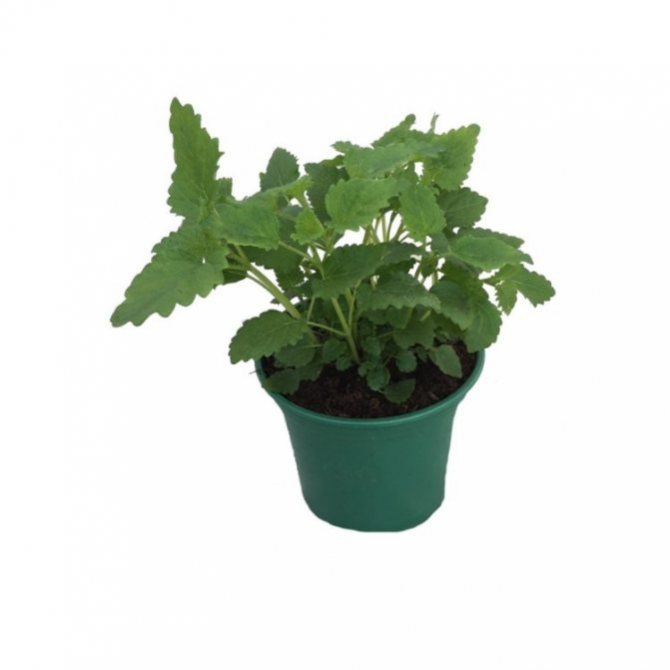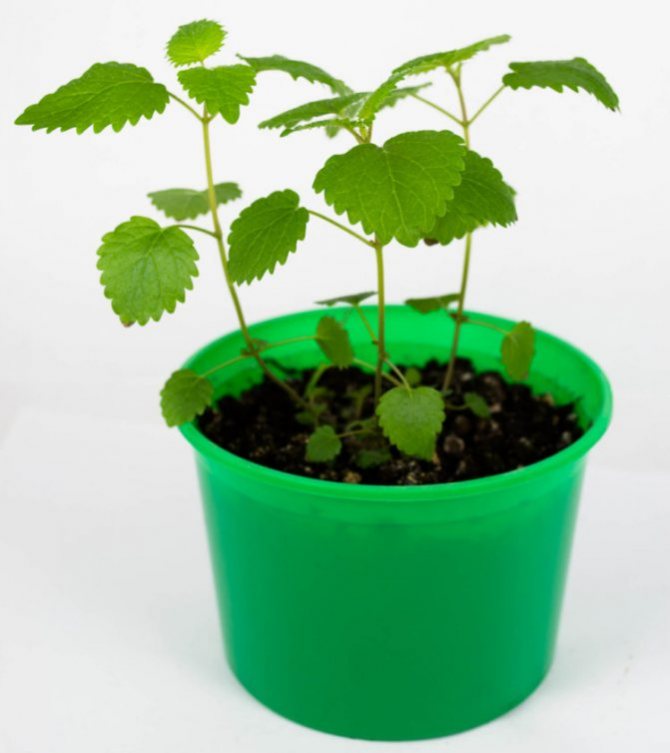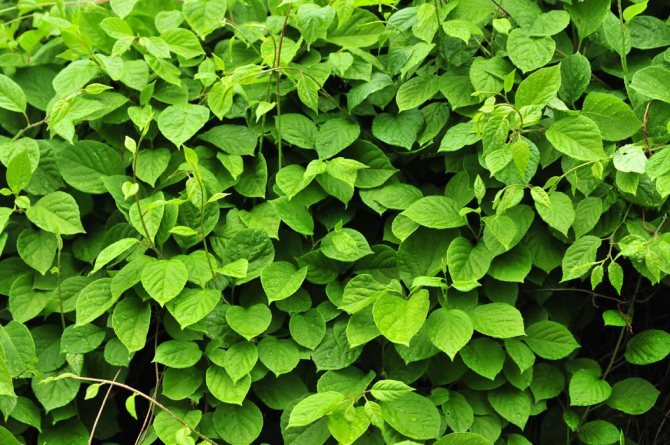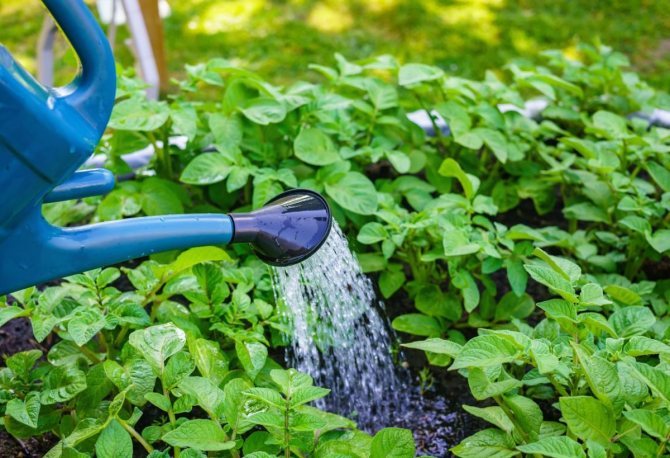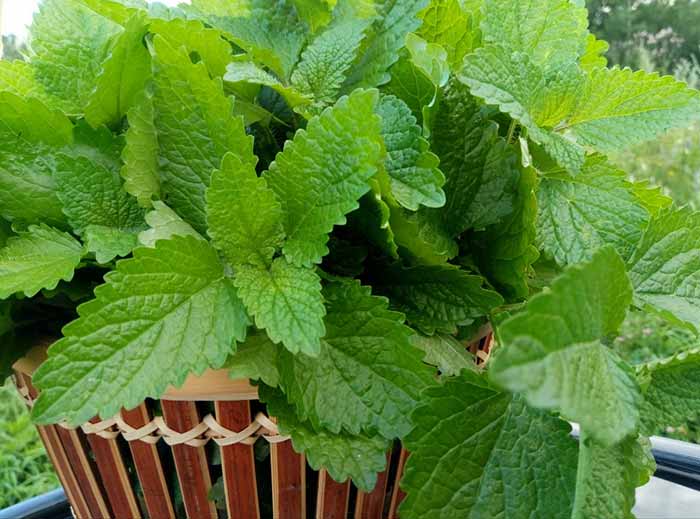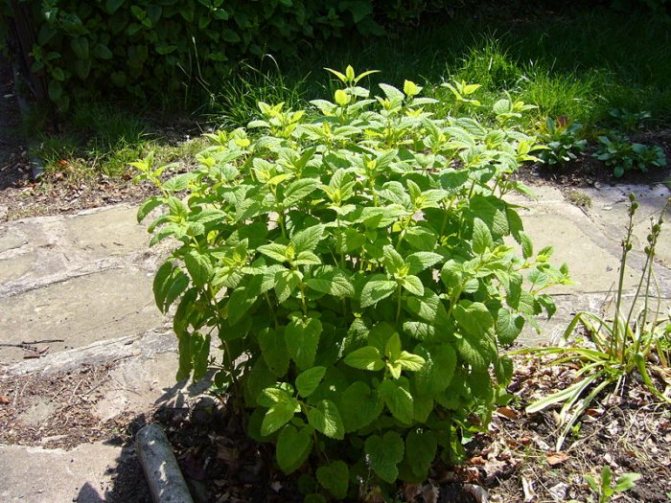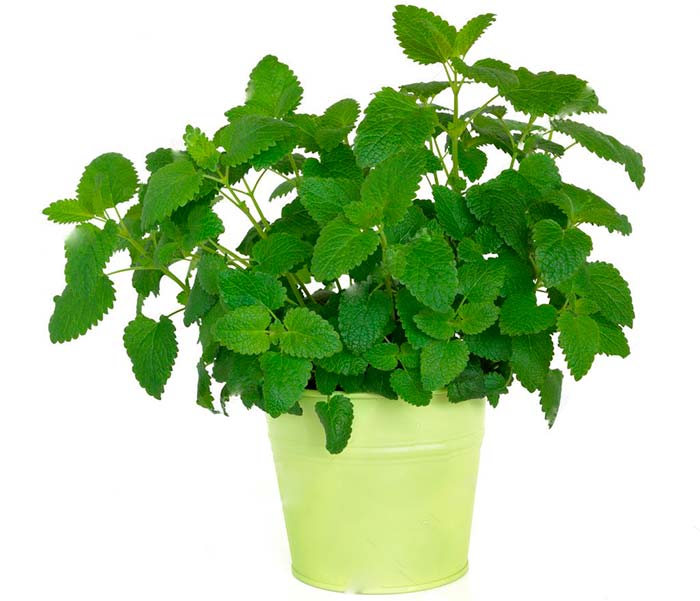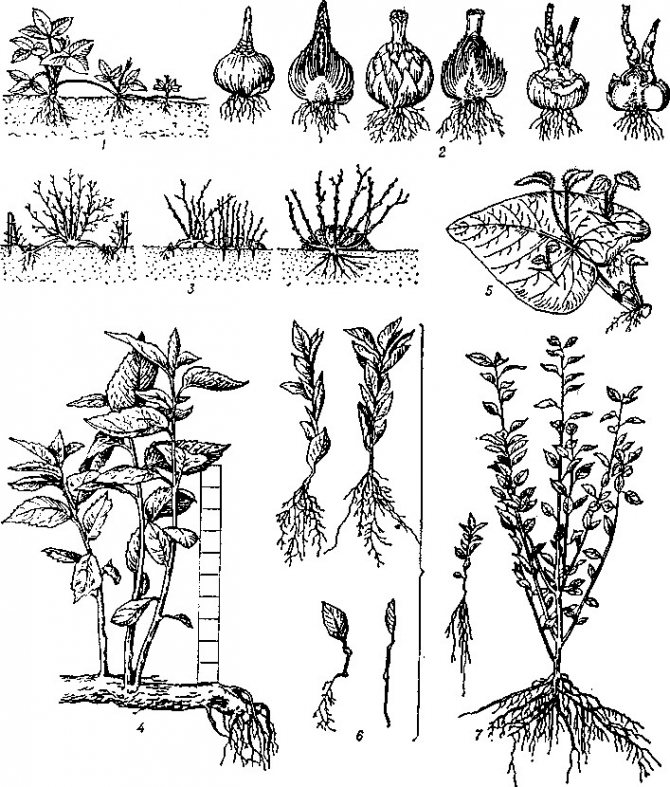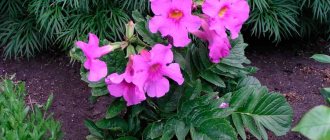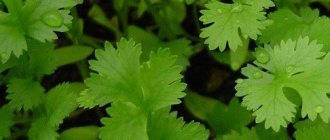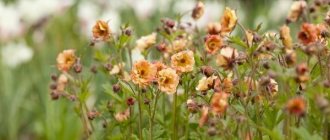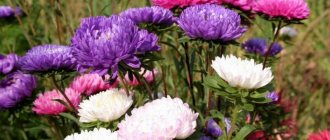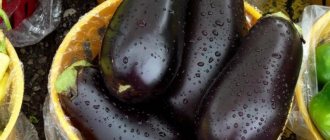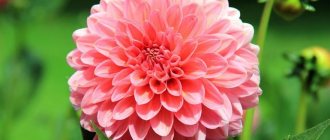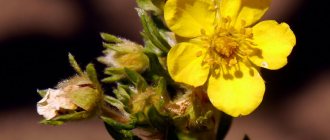Under natural conditions, lemon balm grows in forests located in central Russia. This medicinal plant, widely used in medicine in the treatment of many diseases, has several names among the people:
- mead;
- bee grass;
- lemon mint;
- apiary;
- censer;
- crustacean;
- bee mint.
From an agronomic point of view, lemon balm is a herb belonging to the perennial segment. The color of the leafy part of plants depends on the specific varieties - it can be either green or have a silvery tint.
Note. Melissa planting and care in the open field has some specific features related to the requirements for maintaining the special condition of the soil, but it is also considered a notable characteristic that lemon balm is a melliferous plant, which explains the origin of many popular names.

Melissa
Melissa is found in a wide variety of medications. However, in addition to medical use, the leaves and shoots of this herb, which have a lemon scent, are used in the manufacture of some varieties of culinary products:
- seasoning for dishes;
- additive to canned vegetables;
- improving the taste of liqueurs;
- tea brewing.
When is the best time to sow?
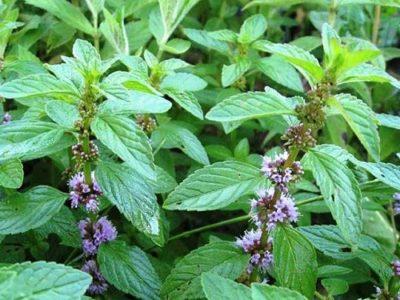

Of the known types of lemon balm, the most popular is Melissa officinalis. In total, 8 varieties are included in the State Register of the Russian Federation, but it is the medicinal one that takes root better than the rest in our climate. Saplings at the time of planting must be at least two months old - these take root faster. Since frosts mercilessly destroy immature sprouts, they should be planted at the end of April, when the danger has passed. All known varieties branch profusely, expanding and spreading roots in breadth, so the allocated space should be spacious enough. 6-7 bushes are enough for both use and storage.
Melissa twins. What can be confused with
Melissa is often confused with other plants. These twins include:
- catnip
- snakehead moldavian.
Let's try to understand their differences.
Melissa is called "lemon mint" by many. In fact, these plants have nothing in common, except for external similarities. mint
and medicinal perennial lemon balm.
The herb called "catnip
"Can also be mistaken for lemon balm. The similar smell of these plants is misleading. In order not to confuse lemon balm with "catnip", you should get acquainted with the fundamental differences between them.
- The scent of lemon balm is gentle, reminiscent of the scent of lemon. The cattleman, on the other hand, smells rather harsh.
- White lemon balm flowers are located in the axils of the plant, and blue catnip inflorescences are in the upper part of the shoot.
- Rounded lemon balm leaves are even at the edges, and oblong catnip leaves are serrated.
- Lemon balm seeds are elongated, and catnip seeds are rounded.
Catnip grows everywhere. This herb is used for cooking and beauty products. It has medicinal properties: it improves appetite, cures cough, relieves worms.
Moldavian snakehead
or "Turkish lemon balm" - an annual plant found in Western Siberia and southern regions of Russia.The essential oils found in snakehead greens are reminiscent of the scent of lemon balm. But its smell is stronger and more pungent. Turkish lemon balm is a favorite of bees and an excellent sedative.
In order not to be mistaken and plant exactly what you need on your site, carefully study the inscription on the package with seeds when buying. For example, lemon balm in translation into Latin is called Melissa officinalis, catnip - Npeta catria, Moldavian snakehead - Dracocphalum moldavica.
Planting and breeding in the open field in the country
Consider how you can propagate and grow lemon mint in your garden or vegetable garden.
Seeds
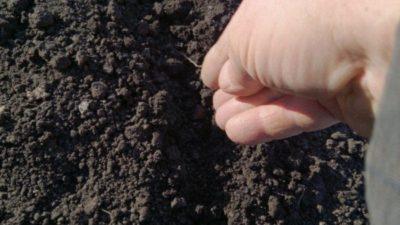

Sowing is carried out in the spring, in well-warmed soil.... Dry seeds are mixed with fine-grained sand and deepened into the soil by 1 cm.
The first shoots can be removed after 20-25 days, and after a month, excess shoots are removed from the beds, leaving a distance of at least 30 cm between them.
Seed reproduction
The easiest and most affordable way to grow this herb in a summer cottage is by seed reproduction. The seeds can be harvested from an adult bush or purchased from a specialized store. Melissa, growing from seeds of which allows you to enjoy freshness throughout the warm period, is not demanding on soil, moisture, tolerates low temperatures perfectly.
The plant is not afraid of frost and feels great even at high temperatures below zero. That is why you can sow seeds at any convenient time - even in the autumn. There are no clear restrictions on sowing aromatic herb seeds. Seeds can be germinated in spring, summer and even late fall. Sowing rules for lemon balm seeds:
- Grows in luxurious bushes. Therefore, it requires enough space for full development. When planting seeds in rows, it is necessary to provide a row spacing of at least 30 cm.
- Sow at the rate of 2 g dry seeds per m2.
- The seeds do not need to be deeply buried. They are sown to a depth of no more than 2 cm.
- The seeds are durable. Even after 3 years of storage, they will give friendly and uniform shoots.
- Dry seeds are sown in open ground. Do it in the spring. For summer planting, it is recommended to use seedlings.
Lemon balm seeds are very small, and seedlings do not differ in abundance at the first stage of growth. That is why professionals recommend mixing lemon balm seeds with other crops, for example, with salad or radish. The seeds are mixed 2: 1 - for 2 parts of an additional culture, 1 part of lemon balm. This approach will allow you not to lose seedlings. Until the culture rises and grows to a noticeable size, the radish or salad can already be eaten. In the first year of growth, young plants bloom but do not set seeds. A scented crop takes time to gain strength and form a mature shrub, ready to seed. Melissa, a simple cultivation and easy care of which allows you to enjoy aromatic tea, gives a full harvest only in the second year of growth. The best option for planting lemon balm from seeds is growing seedlings.
Rules for caring for lemon balm at home
The rules for caring for lemon balm are simple. All she needs is timely watering, the introduction of nutrients and proper pruning. When buds appear, break them off. The main value of lemon balm is its leaves.
Watering and feeding the plant
In the warm season, lemon balm bushes need to be watered as the soil dries 2-3 times a week. For the winter, when the number of sunny days decreases, watering is carried out more economically. Waterlogging of a plant or stagnation of water in the soil can lead to a disease with powdery mildew or root rot, subsequently the bush dies. It is better to feed lemon balm with a special liquid fertilizer.
It is bred according to the instructions. Top dressing is carried out throughout the growing season.
If you want the lemon balm leaves to be more juicy, irrigate it daily with a spray bottle.
Did you know? In ancient Greece, lemon balm was used as an aphrodisiac - a stimulant of sensuality.
How to properly trim lemon balm in a pot


You can start pruning lemon balm after seven weeks, when the plant grows to 15 cm. The more and more often you prune it, the more it will bush. Regular pruning will delay the flowering of the bush. When buds appear, they need to be cut off. After flowering, the leaves become rough.
Transfer
Lemon balm is transplanted into open ground in the second half of May, when it reaches an age of at least 40 days. Before this, a landing hole is prepared. The plant develops well both in illuminated places and in partial shade. But in the light, the aroma will be more intense.
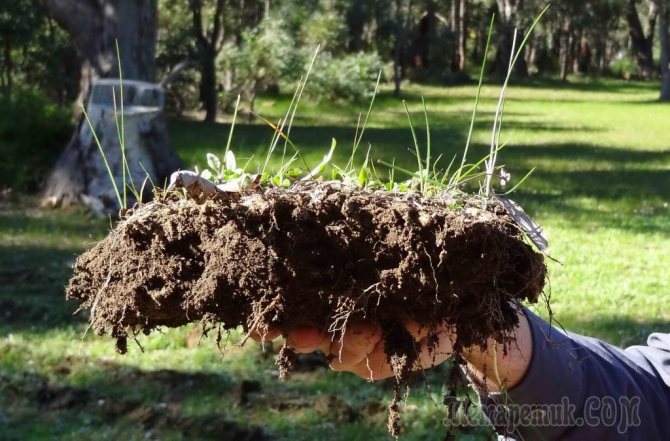

Site and soil requirements
The plot chosen for planting is prepared in the fall, digging up and fertilizing with manure. Loamy soil is preferred. The soil should be nutritious, loose, with neutral acidity or slightly acidic, without stagnation of water, if necessary, provide drainage.
If the soil is heavy, add sand.
Landing technology
In the spring, when the soil warms up, the dug area is loosened, weeds are removed. Lay out a bed, maintaining the distance between rows and between seedlings in a row of 50 cm or more, depending on the variety. As they grow, the bushes begin to branch out and fill in the gaps. When planting in open ground, the plants are planted in shallow trenches, after watering the ground.
Lemon mint - what is this plant
The homeland of the plant is the Middle East and North Africa. It belongs to the Yasnotkov family. An adult plant reaches a height of 30-150 cm. It has a tetrahedral stem on which heart-shaped or ovoid petiole leaves with large teeth are located.
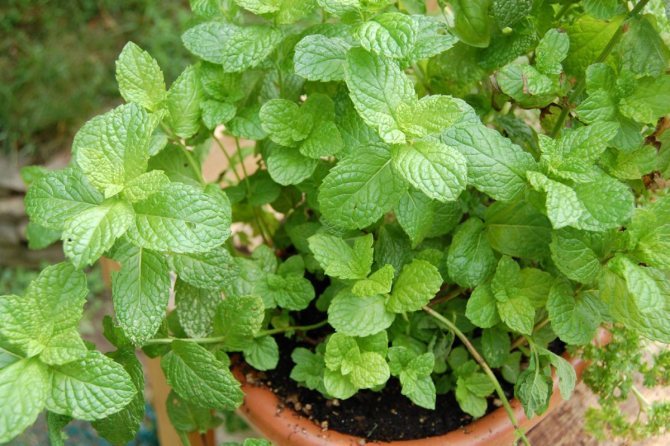

Breeding mint is possible for yourself and for sale
Lemon mint flowers are small. Their main shade is pale pink, lilac or white.
For your information! Lemon balm - lemon mint - has branched stems. In this they differ from simple mint, in which the stem is straight. Additional difference in aroma. Common mint resembles menthol, lemon balm gives off a lemon scent. Both types are used in cooking. One as flavoring, the other as seasoning.
The plant is famous for its beneficial properties, has a medicinal effect. In this, it is not inferior to such medicinal plants as, for example, milk thistle.
- The content of essential oils allows mint to be used as a remedy. A decoction of mint, often when mixed with other medicinal herbs, helps to overcome stress. The broth is also taken for heart disease, when blood pressure is low.
- Decoctions and infusions of peppermint, lemon have a beneficial effect on patients with bronchial asthma, relieve migraine, neuralgia.
- Mint compresses help with gout, joint diseases.
But there is a contraindication: lemon mint should not be taken by people with individual intolerance. In some cases, muscle weakness, constipation, heartburn occur.
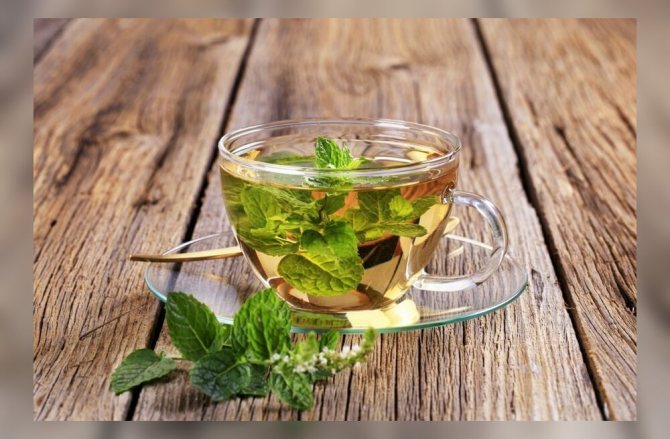

Mint tea helps with many diseases
Melissa - a fragrant medicinal herb


About a thousand years ago, there was a scientist.
Although they did not really know about scientists then - he was just a wise man. This man had a special gift - to notice the beneficial properties of herbs and successfully use them in the treatment of various ailments. And his name was Avicenna. He described in his writings the amazing properties of one widespread plant, which increases vitality, drives away melancholy and cures many diseases. Even earlier, at the time of its heyday, in ancient Greece, even the cult of this herb existed, so it is miraculous. It was the Greeks who began to use it in medicine.And in Russia, refreshing and invigorating drinks were prepared from it. The name of the plant is lemon balm. Years go by, but even now lemon balm often becomes a panacea for many diseases. How and what to treat with this herb, says a women's magazine
About 10 years ago, the author of this article first learned about the existence of lemon balm. It was then that my grandmother planted an incomprehensible grass with a pleasant lemon scent in the country. These were small green bushes 50 centimeters high. I confess that I would hardly have noticed their appearance if not for my long-standing passion for tea. Summer is over, and lemon balm from the dacha smoothly migrated to the family teapot. For what purpose my grandmother put it in black tea, I was not interested at all then, but here is the taste and aroma of tea with lemon balm I could not help but appreciate. A little later, I also learned about the beneficial properties of my favorite tea.


Melissa is an unpretentious plant. It grows in Europe, but it takes root well in Asia, and therefore it was cultivated and began to be bred by many gardeners. There are even lemon balm plantations that grow it for industrial and pharmaceutical purposes. In medicine, lemon balm stems and leaves are used, which are harvested before or at the beginning of flowering, even when it has a fragrant lemon scent. After flowering, this aroma is replaced by an unpleasant odor, somewhat reminiscent of the smell of bedbugs. And this plant blooms throughout the summer. Then it is dried in the shade or ovens. Dry lemon balm and is used as a medicine for many misfortunes. It helps well with asthma, hypertension, various diseases of the stomach, and it relieves pain perfectly. Therefore, a decoction of lemon balm is drunk for migraines and headaches, pain and colic in the stomach, painful menstruation and pain in the heart. Lemon balm has long been known as an excellent sedative, and therefore it is indispensable for any nervous diseases and insomnia. Avicenna has long noted its tonic and tonic properties. This herb stimulates the appetite, adds strength and invigorates the whole day. Due to such a wide spectrum of action, it is used in complex therapy and is added to many herbal preparations.
Very often lemon balm is confused with peppermint (it is even sometimes called lemon mint). Although these are completely different plants, in many ways they are similar, therefore they replace and mutually complement each other. Just like mint, lemon balm helps with toxicosis in the first trimester of pregnancy, relieves vomiting and freshens breath, helps with toothaches. Both mint and lemon balm tea have a pleasant aroma and are excellent thirst quenchers.
Photo
In the photo below you can see how this grass grows in the garden and at home on the windowsill.
How to care?
- Temperature... Melissa is not demanding on temperature and is satisfied with 15-17 degrees. The decrease and increase in temperature also withstands steadily.
- Watering... The basic rule is not to flood. An adult plant needs 3 waterings per week.
- Shine... Good lighting is a prerequisite for good growth of lemon balm. If it is clearly lacking, it is necessary to install additional lighting lamps.
- Priming... Lemon balm prefers loamy soil, well-permeable to air and water, and nutritious. This can be soil from the garden, a mixture of sand, humus or turf, or a ready-made substrate for the store. If it is clayey on the site, then it is necessary to add washed river sand to the landing site. Attention! Selected containers should be processed in a weak solution of potassium permanganate. The height of the pot is no higher than 15 centimeters. At the bottom of the pot, drainage is formed, for which expanded clay, broken brick, fine gravel or clay shards are bought and placed at a height of 2-3 centimeters.
- Top dressing... You need to feed lemon balm once a month.For this, Agrolife is suitable (a teaspoon is enough in the top layer of soil), vermicompost (pour a portion directly into the pot) and Growth (a cap for 2 liters of water when watering). You can alternate mineral (ammonium sulfate, potassium salt, superphosphate) and organic fertilizers (sleeping tea leaves, powdered eggshells).


How to transplant correctly? The transplant is carried out every 2-3 years and very carefully - the slightest damage to the root system leads to the death of the plant.- Pinching... Pinching stimulates the emergence of new branches and the expansion of the bush. You need to do it at a height of 10-15 cm.
- Pruning... The more often the owner trims the lemon balm, the more luxuriant it will bush. In addition, the flowering period with systematic pruning shifts, and the leaf remains soft longer.
- Loosening... Melissa loves this process, it is especially useful to loosen the soil after rain and each watering. This will keep the roots from rotting and will get enough air and liquid.
- Weeding... It should be done as often as loosening.
How to choose a place and prepare the soil for growing lemon balm
In order for lemon balm to grow well, you need to create certain conditions for it.
Lighting for active growth
It is recommended to plant lemon balm in a place with good sunlight, which is especially important for the germination of naturally small seeds. Frosts can kill new lemon mint bushes, so their cultivation should begin with planting in a warm season. In the future, the plant demonstrates a fair resistance to cold weather, although the place where lemon balm grows is still better to choose on the southern side, protected from air currents coming from the north.
Important! In an open, sunny place, lemon balm has a richer aroma.
Preparing the soil for planting lemon balm
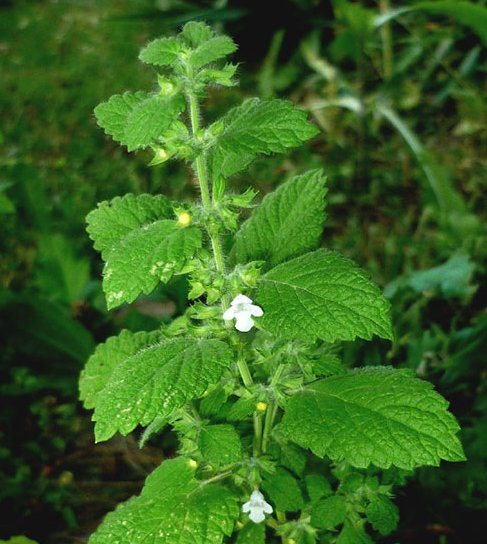

The soil for planting must be fertile and free of weeds. Melissa prefers loamy soils, as they have high water and air permeability, which makes it possible to grow a full-fledged plant. Loose sandstones are also possible. They need good drainage from fine gravel or broken brick, which will protect the root system from decay.
If the entire site is located on clay soil, then at the place of planting lemon balm it must be mixed with river sand. The reaction of the soil to acidity should be slightly acidic or neutral. The first digging with weeding and fertilization can be done in the fall, and in the spring, loosen and clean the heated soil again.
Germinating seeds
Even in spring, sowing lemon balm directly into open ground is very risky. Therefore, it is preferable to start planting seeds in a box or pot on a well-lit windowsill, burying them about 0.5 cm, at a sufficiently large distance from each other (about 5 cm). The optimal time for planting is late March - early April, when the sun is already shining brightly enough for the thermophilic lemon balm, while not drying out tender sprouts. Before germination, which occurs 10-20 days, it is necessary to moisten the soil with warm water, but not too abundantly, so as not to cause fungus in plants, which often appears in excessively wet soil. For a month, the sprouts should be kept at a temperature not higher than 10 degrees.
Growing by seeds
You can breed bee mint by growing it from seeds. Lemon balm seeds are very small, the weight of a thousand pieces does not exceed 0.6 g. For 2-3 years they remain viable. You can sow in open ground or at home for further transplanting it to the street. Practice shows that plants grown in the latter way are stronger and more hardy.
Getting seedlings
Sowing seeds for seedlings begins in the second half of March. In a container with soil, several furrows are made with a distance of 4–6 cm between them. To facilitate sowing of small seeds, they are mixed with a small amount of sand. The resulting mixture is spread into grooves to a depth of 0.5–0.7 cm, the soil is moistened.The container is covered with glass or foil and placed in a warm, sunny place. After the emergence of shoots, the container must be transferred to a lighted place, but not under the scorching sunlight. When the seedlings grow up to 3–5 cm, they are thinned out, leaving an interval of 5 cm. As the soil dries, they are watered.
Gardeners usually pinch seedlings when they reach a height of 10-15 cm. Then the bushes form compact and branched.
Sowing in open ground
When to plant seeds outdoors depends on the variety you choose. They will sprout quickly if we sow them at the end of May. The planting depth is no more than 1–1.5 cm. It is advisable to leave 50 cm between the rows, and at least 40 between the bushes.
The seeds are usually mixed with sand, sprinkled with peat or humus on top, moisten the soil and cover with a film. The first shoots will appear in 3 weeks.
To harden the plants, it is necessary to open them periodically, gradually increasing the time. After diving, the film can be removed.
Diseases
Most often, the owner encounters two troubles when growing lemon balm: rust (characterized by the appearance of dark brown bulges on the back of the leaves) and septoria (numerous light spots with a brown border appear on the leaf plates). Rust is caused by excess nitrogen in the soil and high humidity, septoria - Septoria fungus.
In the first case, the treatment is simple: the affected leaves are cut off from the plant and treatment is carried out with any fungicide. But septoria is much more dangerous: since the fungi that cause this ailment are very tenacious, re-infection often occurs through the soil. In this case, the plant can only be burned, discarded the soil and disinfected the pot. The garden area should be treated with fungicide several times.
Why do the leaves of the plant darken, turn black, or turn yellow? If the leaves of lemon balm began to turn black, the owner waters it too generously. The amount of water should be reduced by half and the soil should be loosened more often.
And here yellowing tips indicate a lack of water and too dry soil... The owner should urgently increase the amount of liquid.
The appearance of spots on the leaves may indicate either the onset of verticillary wilt or anthracnose. Both diseases are caused by pathogenic fungi, but only in the second case the plant can be saved by spraying 3-4 times with Bordeaux liquid.
Pests - diagnosis and control
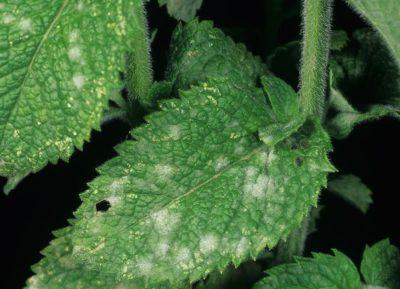

Melissa attracts not only people but also pests. Most often these are spider and spotted mites, whiteflies, and aphids. After the appearance of these unpleasant insects, lemon balm stops growing and withers. Ticks entangle the plant with a thin cobweb, the whitefly leaves behind a sugary discharge, on the basis of which a sooty fungus develops, the aphid settles on the seamy side of the leaves in colonies and drinks all the juices from the plant.
You can try to clean the house plant with a hot shower, followed by a bath in soapy water or garlic broth., and a garden plant - by spraying with special insecticides ("Aktara", "Iskra", "Tanrek"). Biological products are also recommended - "Fitoverm", "Trichopol", "Aktofit", "Fufanon", "Jaguar".
Preliminary processing
Lemon balm seeds do not need to be pre-soaked in warm water or germinatedlike the seeds of many other crops. Usually, before sowing, they are disinfected by pickling in a 1% solution of potassium permanganate, in order to avoid contamination with infectious diseases of the soil and future plants.
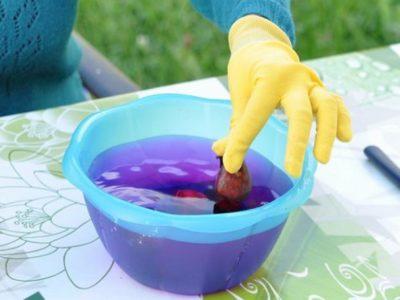

It is necessary to prepare lemon balm seeds, a small container, boiled cold water, potassium permanganate, a cloth.- Pour 100 ml of water into a prepared container.
- 1 gram of the drug is added to the water, the solution should be mixed well.
- Place the spice seeds in a cloth napkin, tighten the napkin well.
- Place the resulting bundle in a solution of potassium permanganate for 20 - 30 minutes.
- At the end of the time, the bundle should be thoroughly rinsed with running water.
- The seeds must be removed from the "bag" and allowed to dry.
Varieties and varieties
There are many varieties and varieties of plants. They differ:
- the height and shape of the bush;
- aroma intensity;
- shades of leaves and flowers;
- resistance to cold weather.
Lush, up to 1 m tall bushes of the "dozia" variety. Leaves are dark green with denticles, strong odor. The flowers are white. "Pearl" has corrugated leaves with large teeth. Withstand Russian winters:
- "quadrille";
- "freshness";
- "Isidora";
- "Lada", etc.
They are distinguished by a special decorativeness of varieties with leaves of golden shades:
- "Pure gold", the white flowers of which eventually turn into light lilac;
- "Golden" ("variegated") with dark green leaves covered with a variegated golden pattern.
The plant is an excellent honey plant. All varieties of lemon balm attract bees with their scent.
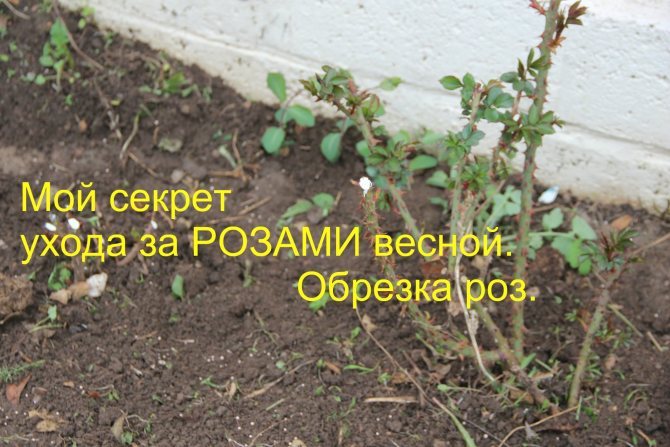

When and how to harvest?
You can harvest lemon balm 3-4 times a year from one bush. Experienced gardeners are advised to adhere to certain rules:
- Collect raw materials on a cloudy afternoon or early in the morning, immediately after the dew has melted.
- Do this not earlier than the beginning of flowering, ideally in the month of June. The leaves at this time are still very young, have a delicate aroma and delicate taste. Over time, the above characteristics increase, but the leaves become tough.
- Greens are cut at a height of 10 centimeters and above.
Care
To avoid difficulties in growing lemon balm, it is necessary to properly organize the care from the first year:
- loosening the soil;
- watering;
- weeding;
- top dressing;
- pruning.
First of all, it is necessary to regularly loosen the soil and weed weeds. Up to 3 times per season, the plant is cut 10 cm from the ground. Bushes quickly recover, become more luxuriant, forming new branches.
For the winter, it is recommended to cut lemon balm, leaving no more than 2 cm. The earth is loosened, slightly moistened and covered with fallen leaves.
Every three years, the bushes must be divided, otherwise the leaves become small.
Proper watering
In hot weather, plants are watered 3-4 times a week, on cloudy days it is enough 2. To prevent root decay, after the procedure, the soil must be loosened. They do the same after the rain.
Nutritional requirements
After planting and when the seedlings in the open field reach 5–6 cm, they are fed with nitrogen compounds for the growth and strengthening of the stem. If the leaves are trimmed during the season, after each procedure it is necessary to apply a complex mineral fertilizer, following the instructions for use.
It is recommended to mulch the garden bed with humus or compost several times.
Top dressing is not done before the flowering of lemon balm, since this leads to untimely ripening of the seeds.
Disease and pest control methods
Melissa suffers from diseases such as:
- rust;
- septoria.
To combat them, the affected parts of the plant are cut off, sprayed with Bordeaux liquid and treated with fungicides. Re-infection with septoria can occur due to the fact that the pathogen remains in the soil. Diseased plants are removed and burned. The area is then treated with fungicides several times.
The green beetle - mint leaf beetle - is the most dangerous pest. He eats foliage. To get rid of it, you should remove the growing wild varieties of lemon mint. And the places where they grew up should be treated with insecticides.
Useful properties and contraindications
Lemon balm has a number of beneficial properties. Leaves and young shoots have a pleasant lemon scent, they taste bitter, contain:
- vitamin C;
- carotene;
- essential oils;
- tannins.
The plant has a calming effect on the nervous system, it is used as a sedative.
The tincture helps with heart disease and hypertension. But it is not recommended to use lemon balm for treatment without a doctor's prescription.
Lemon mint lowers blood pressure, so people with hypotension should be careful when using this plant for medicinal purposes.
Vegetative reproduction of lemon balm
If you already have one lemon balm bush, but this is not enough, then you can propagate the plant vegetatively, without resorting to sowing seeds. Bend a few lemon balm twigs to the ground, pin and sprinkle with earth - they will take root. This procedure should be carried out in early summer.
Remember to regularly water the soil around the plant so that the sprinkled twigs can take root. And in the spring it will be necessary to separate them from the mother bush and put them in a permanent place.
Melissa at least three years old can be propagated by dividing the bush. It is better to do this in early spring, when the plant is just emerging with young shoots, or at the end of August. We cut the mother bush into pieces of approximately equal size, so that each division has at least 4 shoots with roots.
Flowering features
The first bloom depends on the growing method... A plant grown from seeds undergoes a long adaptation to new conditions (at least a year), so you should not expect flowering from it at this time. In other cases, flowering in the first year is also very rare.
The first flowers appear in the axils of the leaves and there are few of them. The petals are lilac, pink or milky white. The following years, melissa pleases with a more abundant bouquet.
Having received its name in honor of the ancient Greek nymph Melissa, the plant to this day does not cease to be a real find for lovers of sophistication. Subtle notes of mint and honey heal, soothe, give food and drinks a special piquant taste and unforgettable aroma. Try to grow this little miracle on your plot or in your house - you will definitely not regret it!
Growing a house on a windowsill
Melissa can be cultivated at home as a houseplant. If you take a small pot, it will not grow much. With the help of pruning and constant care, you will get a lush compact bush on the windowsill.
For growing at home, the rules are the same as for open ground. When to plant to get a houseplant from seed doesn't matter. After the appearance of the third leaf, the seedlings dive into separate pots. The containers must correspond to the following dimensions: volume 1.5–2 liters, height - up to 15 cm. Drainage from pebbles or expanded clay is laid at the bottom of the pot. Pour the prepared soil, plant 2-3 sprouts in each pot. Moisten the soil with a spray bottle. They are placed on the windowsill.
To maintain the proper quality of the leaves, abundant watering and regular spraying of the plant are necessary.
The plant is replanted every 3-4 years, renewing the soil in the pot. In winter, without additional lighting, the bush will grow, only the leaves will brighten a little.
Melissa: plant description
The height of a perennial can reach one and a half meters. Its basis is a highly branching rhizome. Petiolate opposite leaves of a complex shape, resembling both a heart and an egg and having large teeth, are located on a branched stem, as if cut on four sides.
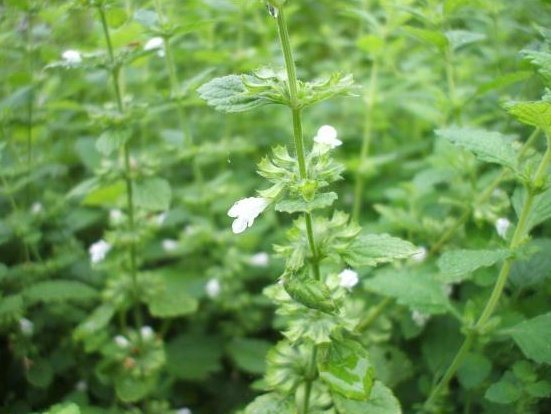

Short pedicels are crowned with axillary bunches of small white flowers, which can also have pale pink or purple tones. The flowers have four stamens, the upper four-part ovary of the pistil is on a long column. The flowering of lemon balm marks July and August of the second year of growth.
A large, with black sheen, four-root fruit, which matures in August-September, is ovoid. Before flowering, the herb smells like lemon. When the bloom ends, the fading odor becomes unpleasant.



